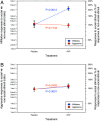Nebulized vasopressin penetrates CSF and improves social cognition without inducing aggression in a rhesus monkey model of autism
- PMID: 39585977
- PMCID: PMC11626171
- DOI: 10.1073/pnas.2418635121
Nebulized vasopressin penetrates CSF and improves social cognition without inducing aggression in a rhesus monkey model of autism
Abstract
Low cerebrospinal (CSF) arginine vasopressin (AVP) concentration is a biomarker of social impairment in low-social monkeys and children with autism, suggesting that AVP administration may improve primate social functioning. However, AVP administration also increases aggression, at least in "neurotypical" animals with intact AVP signaling. Here, we tested the effects of a voluntary drug administration method in low-social male rhesus monkeys with high autistic-like trait burden. Monkeys received nebulized AVP or placebo, using a within-subjects design. Study 1 (N = 8) investigated the effects of AVP administration on social cognition in two tests comparing responses to social versus nonsocial stimuli. Test 1: Placebo-administered monkeys lacked face recognition memory, whereas face recognition memory was "rescued" following AVP administration. In contrast, object recognition memory was intact and did not differ between administration conditions. Test 2: Placebo-administered monkeys did not respond to conspecific social communication cues, whereas following AVP administration, they reciprocated affiliative communication cues with species-typical affiliative responses. Importantly, AVP administration did not increase aggressive responses to conspecific aggressive or affiliative overtures. Study 2 (N = 4) evaluated the pharmacokinetics of this administration method. Following AVP nebulization, we observed a linear increase in cisternal CSF AVP levels, and a quadratic rise and fall in blood AVP levels. These findings indicate that nebulized AVP likely penetrates the central nervous system, selectively promotes species-typical responses to social information, and does not induce aggression in low-social individuals. Nebulized AVP therefore may hold promise for managing similar social symptoms in people with autism, particularly in very young or lower functioning individuals.
Keywords: autism; primate model; rhesus monkey; social functioning; vasopressin.
Conflict of interest statement
Competing interests statement:The Board of Trustees of the Leland Stanford Junior University filed a US patent application, 11,951,149 (“Intranasal Vasopressin Treatment for Social Deficits in Children with Autism”). This patent has not been licensed.
Figures




Comment in
-
Development of precision medicine approaches to advance clinical trials for autism and social behavior: A research imperative.Proc Natl Acad Sci U S A. 2025 Jan 7;122(1):e2424066122. doi: 10.1073/pnas.2424066122. Epub 2024 Dec 30. Proc Natl Acad Sci U S A. 2025. PMID: 39793093 Free PMC article. No abstract available.
References
-
- American Psychiatric Association, Diagnostic and statistical manual of mental disorders: Diagnostic Criteria for Autism Disorder (DSM-5®) (American Psychiatric Association, ed. 5, 2013).
-
- Klin A., et al. , A normed study of face recognition in autism and related disorders. J. Autism. Dev. Disord. 29, 499–508 (1999). - PubMed
-
- Ziv Y., Hadad B. S., Khateeb Y., Social information processing in preschool children diagnosed with autism spectrum disorder. J. Autism. Dev. Disord. 44, 846–859 (2014). - PubMed
MeSH terms
Substances
Grants and funding
LinkOut - more resources
Full Text Sources
Medical
Miscellaneous

